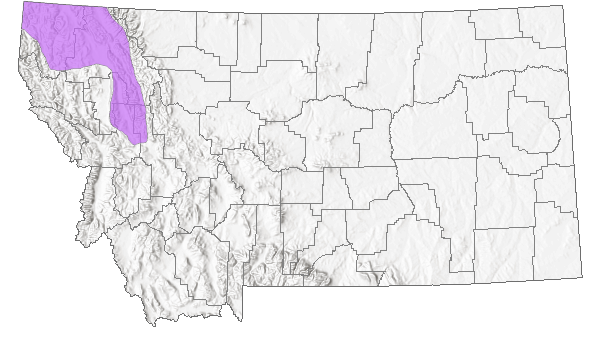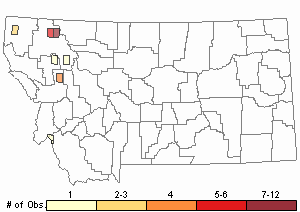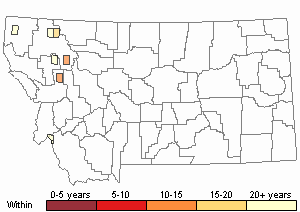View in other NatureServe Network Field Guides
NatureServe
Montana
Utah
Wyoming
Idaho
Wisconsin
British Columbia
South Carolina
Yukon
California
New York
Glaucus Beaked Sedge - Carex rostrata
State Rank Reason (see State Rank above)
This is a rare species in Montana, not to be confused with the more common Carex utriculata, which had been mistakenly treated under the name Carex rostrata in many past Floras.
General Description
Beaked Sedge is a perennial, grass-like plant with a single or several round stems, 5-12 dm tall, which arise from extensive, creeping rhizomes. The leaves are 1-4 mm wide and have dense, microscopic bumps on the upper surface and inrolled margins; they are covered with a whitish, waxy coating that rubs off. Flowers are clustered in cylindical spikes which are 2-10 cm long and arise on erect to spreading stalks from the axils of the upper leaves (bracts). The lowest bract leaf is as long or longer than the inflorescence. Male flowers are borne in 1-3 narrow spikes at the top, and 3-6 female spikes, ca. 1 cm thick, occur below. The glabrous, inflated, spreading, pale green to light brown, egg-shaped perigynium is 4-7 mm long and has a beak that is 1-2 mm long. The papery scales have needle-like tips and are about as long and broad as the perigynia that they subtend. There are 3 styles, and the achene is 3-sided.
Phenology
Fruiting in July-August.
Diagnostic Characteristics
Carex rostrata is very similar to the common species, Carex utriculata. Carex rostrata can be distinguished from Carex utriculata by its narrower leaves (2-4mm wide vs >4mm wide) which tend to be rolled versus flat or v-shaped in Carex utriculata and that are glaucous and bluish-green versus yellow-green.
Species Range
Montana Range
Range Descriptions

 Native
Native
Range Comments
Circumboreal, south to WA, ID, MT and WI (Lesica et al. 2012. Manual of Montana Vascular Plants. BRIT Press. Fort Worth, TX).
Observations in Montana Natural Heritage Program Database
Number of Observations: 28
(Click on the following maps and charts to see full sized version)
Map Help and Descriptions
Relative Density

Recency



 (Observations spanning multiple months or years are excluded from time charts)
(Observations spanning multiple months or years are excluded from time charts)
Habitat
Wet, organic soils of fens in the montane zone, including floating peat mats.
National Vegetation Classification System Groups Associated with this Species
Wetland and Riparian
Peatland
Stewardship Responsibility
Threats or Limiting Factors
STATE THREAT SCORE REASON
Threat impact not assigned because threats are not known (MTNHP Threat Assessment 2021).
References
- Literature Cited AboveLegend:
 View Online Publication
View Online Publication Britton, N. L. and A. B. Brown. 1913. An Illustrated Flora of the Northern United States, Canada, and the British Possessions. 2nd Edition in 3 Volumes. New York, NY: Charles Scribner's Sons. B13BRI01PAUS.
Britton, N. L. and A. B. Brown. 1913. An Illustrated Flora of the Northern United States, Canada, and the British Possessions. 2nd Edition in 3 Volumes. New York, NY: Charles Scribner's Sons. B13BRI01PAUS. Lesica, P., M.T. Lavin, and P.F. Stickney. 2012. Manual of Montana Vascular Plants. Fort Worth, TX: BRIT Press. viii + 771 p.
Lesica, P., M.T. Lavin, and P.F. Stickney. 2012. Manual of Montana Vascular Plants. Fort Worth, TX: BRIT Press. viii + 771 p. MTNHP Threat Assessment. 2021. State Threat Score Assignment and Assessment of Reported Threats from 2006 to 2021 for State-listed Vascular Plants. Botany Program, Montana Natural Heritage Program, Helena, Montana.
MTNHP Threat Assessment. 2021. State Threat Score Assignment and Assessment of Reported Threats from 2006 to 2021 for State-listed Vascular Plants. Botany Program, Montana Natural Heritage Program, Helena, Montana.
- Additional ReferencesLegend:
 View Online Publication
View Online Publication
Do you know of a citation we're missing? Ament, R.J. 1995. Pioneer Plant Communities Five Years After the 1988 Yellowstone Fires. M.Sc. Thesis. Bozeman, MT: Montana State University. 216 p.
Ament, R.J. 1995. Pioneer Plant Communities Five Years After the 1988 Yellowstone Fires. M.Sc. Thesis. Bozeman, MT: Montana State University. 216 p. Cronquist, A., A. H. Holmgren, N. H. Holmgren, J. L. Reveal, and P. K. Holmgren. 1977. Intermountain flora: Vascular Plants of the Intermountain West, U.S.A. Volume 6: The Monocotyledons. New York, NY: Columbia University Press. 584 pp.
Cronquist, A., A. H. Holmgren, N. H. Holmgren, J. L. Reveal, and P. K. Holmgren. 1977. Intermountain flora: Vascular Plants of the Intermountain West, U.S.A. Volume 6: The Monocotyledons. New York, NY: Columbia University Press. 584 pp. Gaudet, C. L. 1988. The relationship between plant competitive ability, morphology and field distribution; implications for conservation of rare species. Canadian Plant Conservation Programme Newsletter 3(1):18-19.
Gaudet, C. L. 1988. The relationship between plant competitive ability, morphology and field distribution; implications for conservation of rare species. Canadian Plant Conservation Programme Newsletter 3(1):18-19. Hollenbeck, R.R. 1974. Growth rates and movements within a population of Rana pretiosa pretiosa Baird and Girard in south central Montana. Ph.D. Dissertation. Bozeman, Montana: Montana State University. 66 p.
Hollenbeck, R.R. 1974. Growth rates and movements within a population of Rana pretiosa pretiosa Baird and Girard in south central Montana. Ph.D. Dissertation. Bozeman, Montana: Montana State University. 66 p. Horpestad, A.A. 1969. Factors affecting the distribution and abundance of aquatic macrophytes in parts of the Madison, Firehole and Gibbon Rivers. M.Sc. Thesis. Bozeman, MT: Montana State University. 88 p.
Horpestad, A.A. 1969. Factors affecting the distribution and abundance of aquatic macrophytes in parts of the Madison, Firehole and Gibbon Rivers. M.Sc. Thesis. Bozeman, MT: Montana State University. 88 p. Law, D.J. 1999. A comparison of water table dynamics and soil texture under black cottonwood recent alluvial bar, beaked sedge, and Geyer's/Drummond's willow communities. M.Sc. Thesis. Bozeman, MT: Montana State University. 68 p.
Law, D.J. 1999. A comparison of water table dynamics and soil texture under black cottonwood recent alluvial bar, beaked sedge, and Geyer's/Drummond's willow communities. M.Sc. Thesis. Bozeman, MT: Montana State University. 68 p. Lesica, P., M.T. Lavin, and P.F. Stickney. 2022. Manual of Montana Vascular Plants, Second Edition. Fort Worth, TX: BRIT Press. viii + 779 p.
Lesica, P., M.T. Lavin, and P.F. Stickney. 2022. Manual of Montana Vascular Plants, Second Edition. Fort Worth, TX: BRIT Press. viii + 779 p. Reznicek, A.A. 1997. The true Carex rostrata in the American Rockies. Sage Notes. A publication of the Idaho Native Plant Society 19(4):11-13.
Reznicek, A.A. 1997. The true Carex rostrata in the American Rockies. Sage Notes. A publication of the Idaho Native Plant Society 19(4):11-13.
- Web Search Engines for Articles on "Glaucus Beaked Sedge"





